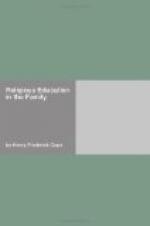Thirdly, keep a record of sources of stories. This may be preserved in a notebook. One parent used a card-index for this purpose. There are a few books published containing good collections.[17] You will find most valuable your own little book in which you have noted down the fugitive stories and short selections which are to be found in general literature.[18]
Fourthly, do not tell a story so as to close the child’s interest in the narrative. Stories ought to lead to inquiry and further reading in the book or other source from which they have been drawn; indeed, story-telling is one excellent method of quickening an interest in reading.
Fifthly, allow the children to retell the stories to one another. Often the whole family will be entertained and helped by the explanation which a small child will give of the story he has learned by hearing it repeated a few times from his mother’s lips.
Sixthly, telling Bible stories to children in the quiet hour is the best of all methods to stimulate their interest in the Bible itself. It is much better to tell the story in your own language than to read it either in the Bible or in a paraphrase. For one reason, you will never tell it twice the same way, and children will watch with interest changes in the narration. As soon as they can read, secure some of the simple Bible narratives and put these in their hands.[19]
Sec. 2. BOOKS AND READING
A home without books is like a house with only one window; it can look out in only one direction, in that of the present. It knows only a limited world; its children have a short measure of the joy of life, they can know here only those whom they see today, their friends must be few, their world narrow and confined.
If the books are not in your home the children will find them elsewhere. Unless the school kills the taste for reading, as it sometimes does, the young folks will open ways somehow into the ideal realm of books. As they grow up, the book takes the place of the story. The printed page is the child’s key to all routes of travel, routes that lead to other times and lands, routes that lead to other people and into their hearts and minds. The child sees conduct and feels it as it is in action in lives before him, but he begins to discriminate and to analyze it only through reading; souls are revealed where the purpose of the writer is that the reader may see the springs of action in the character portrayed. Fiction, biography, travel, and adventure soon pass from the merely exterior happenings to the discovery of meanings in character.




